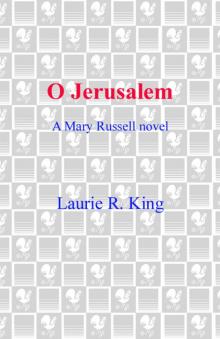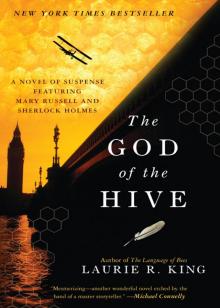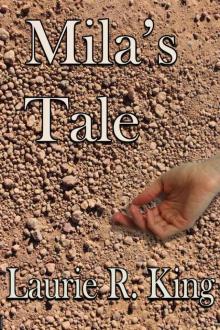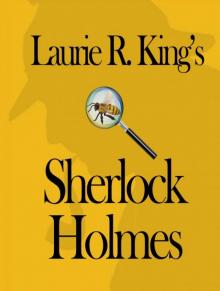- Home
- Laurie R. King
Laurie R. King's Sherlock Holmes Page 3
Laurie R. King's Sherlock Holmes Read online
Page 3
Baring-Gould was minor English gentry, a member of that unfortunately-named category called “squarsons” that cobbles together the words “squire” and “parson.” He was the squire of Lew Trenchard manor on the edge of Dartmoor, and after spending much of his career as a parson elsewhere in England, returned home to raise fourteen children, whom he supported with an endless stream of books ranging from turgid bodice-rippers to completely unresearched volumes of the lives of saints, a natural history of the werewolf, and popular hymns (“Onward Christian Soldiers” and “Now the Day is Ended” but two.) He regarded his greatest achievement as his ongoing collection of local folk-music, many of which he brutally rewrote to make more palatable for proper English lips and sensibilities.
Also guidebooks. That was where I began, with his guide to Dartmoor that I discovered in the Oxford public library. In October I took a third trip to the moor (Oh, the things my kids could tell you about the life of a novelist’s family!) to look at it in greater detail, and we stayed for a night at Baring-Gould’s home, Lewtrenchard Manor, which had been gently converted into an upscale hotel. The owners were kind enough to put up with a trio of untamed Californians, overlooking the fact that our dinner dress was by no means up to the requested formality But they allowed me to crawl all over the house, seeing the Baring-Gould study and bedroom, peeking into the lovely ball-room (closed for repairs at the time) and finding all kinds of nooks and crannies in which one might dump a body, all of it serving to add colour to Russell’s adventure.
Back home in California, the book research got under way. I had been immensely relieved to find that Sabine Baring-Gould was still alive when my characters needed to visit Lew, in September and October, 1923—true, he would probably have been too ill to act as host to his visitors, but it is a novelist’s prerogative to twist the truth just a little, and I really wanted him to appear as an active character in the book, not as a man in his death-bed.
And what a character he was. I worked my way through as many of the novels as I could bear, finding some of them actually readable, and laid my hands on such gems as The Book of Were-Wolves and his canned biographies of various saints. I also realized that I already had a Baring-Gould in my personal library, a slim volume I’d picked up from a remainder table as an impoverished undergraduate: Curiosities of the Middle Ages.
My local university research library unearthed his two-volume autobiography, I dove in with pleasure, then puzzlement, and finally a peculiar sense of familiarity. Hadn’t I read some of this before? It took a while, but eventually the light-bulb went on: his grandson, William Stuart Baring-Gould, was an eminent scholar of Sherlock Holmes, and had written a biography of Sherlock Holmes.
When I put W. S. Baring-Gould’s Sherlock Holmes of Baker Street next to Sabine Baring-Gould’s Early Reminiscences, I found a number of, shall we say, quite striking similarities.
From Early Reminiscences
Sabine Baring-Gould was born on the 28th of January, 1834. “My father had been a cavalry lieutenant in the East Indian Company’s service—uniform blue and silver. He met with an accident: whilst driving a stout friend in his dog-cart, the vehicle was upset and the friend fell on him and dislocated his hip. He was not carefully treated, and was sent home invalided.” And later, “On 6 July, 1837, we left England in the steam vessel, Leeds, for Bordeaux….From Bayonne the whole party moved for the winter to Pau, where we took a flat on the Grande Place.”
In the summer of 1838, the Baring-Gould family moved on to Montpellier where, as young Sabine’s mother wrote, “We were not a little glad to find a delightfully snug and pretty little house…in the best part of the town” which had “a piece of water in the middle (very shallow) and railed around to the height of Sabine’s waist, full of gold fish, which serve to delight the little ones.”
“In October, 1840…we crossed to Rotterdam….We remained for some time at Cologne, as the weather was breaking up and winter setting in, so that it was not convenient for travelling.
“One drawback to going abroad had been the publication in numbers of Nicholas Nickleby, that was begun in 1839, and odd as it may seem, I think that really one reason for inducing my father to spend the winter at Cologne was that he might be more certain to obtain the issues of that story as they came out.”
From Sherlock Holmes of Baker Street:
Sherlock Holmes was born twenty-two days and twenty years later, on 6 January, 1854, to “a young cavalry lieutenant in the services of the East India Company—uniform blue and gold—[who] had offered, one evening, to drive a friend home from the company mess.
Perhaps the dinner had been an exceptionally good one. Certainly both the cavalry lieutenant and his friend were heavy men, each weighting in the neighborhood of fourteen stone. In any case, it followed that the dogcart shortly turned over. The friend fell upon his companion, the cavalry lieutenant. The friend was unhurt, but the hip of the cavalry lieutenant was dislocated, and he was invalided home without delay.”
When Sherlock was a year old, his father, the retired officer, “led his entire family aboard the steamship Lerdo on July 7, 1855. They were bound for Bordeaux, across the Bay of Biscay. From Bordeaux they traveled to Pau, and there they wintered, taking a flat in the Grande Palace.”
In May, 1858, the family removed to Montepellier, where “they took a snug and pretty little house in the best part of town…with a goldfish pool to delight Sherlock and his brothers.”
And “in October 1860 they crossed to Rotterdam. Two months later this wandering family, these genteel gypsies, pitched tent in Cologne. The Rhine in that winter of 1860-61 was frozen over, and the while family had several months of peace during with Siger Holmes [the father] continued his studies.”
* *
And there you have it: Take your grandfather’s story and add twenty years and a touch of decorative detail, change the steamship from Leeds to Lerdo, and interpret a passion for Nicholas Nickleby as “studies,” and you have quite a nice childhood for a detective. You also provide a novelist, decades later, the opportunity to reveal that a certain famous misanthropic detective is in fact the god-son of the squire of Lew Trenchard.
I like to believe that the old curmudgeon might have been mildly amused at my novelist’s impertinence.
Perhaps both old curmudgeons.
III. A Holmes Chronology
Readers of the Mary Russell books, beginning with The Beekeeper’s Apprentice, will notice that the Sherlock Holmes they contain is a somewhat younger man than most Holmesians (or Sherlockians, on the left side of the Atlantic) have been led to expect. He is, after all, long retired to the Sussex Downs (as seen in the preface of His Last Bow) and the Sidney Paget drawings of him that accompanied the original Strand magazine publications depicted a man already middle aged in the 1880s. So what’s this with referring to him in 1915 as “fifty four”?
First of all, we must remember that specific references to age and even dates are both rare and conflicting within the Conan Doyle canon. Sir Arthur was not aiming to construct a fictional biography; he was writing tales to entertain, and often couldn’t be bothered with the details.
Let us look at two of the stories that do give certain reference points of dates.
A Study in Scarlet
The initial appearance of Holmes and Watson into each other’s lives, and into ours, comes in A Study in Scarlet, published in the 1887 Christmas issue of Beeton’s Annual. It is narrated, as are most of the Holmes tales, by Dr John Watson, who tells of receiving his medical degree in 1878 and going to India in time for the Second Afghan War, which began in the fall of that year.
Watson would have arrived on the Northwest Frontier in1879, and was woundedii in the battle of Maiwand, July 27, 1880. He was evacuated when the relief forces arrived (in September), then lay with “months” of fever before being sent home to England with nine months’ of medical pension.
In London, Watson meets an old colleague, complains to him of the high cost of living in the city,
and is taken to meet a rather peculiar fellow who also happens to be looking to share rooms. “You have been in Afghanistan, I perceive,” Holmes tells Watson, and the doctor and the audience are hooked. This meeting in the laboratories of St Bart’s hospital would have taken place in early 1881, and over the next weeks of sharing Mrs Hudson’s house, Holmes is making his first ventures into the profession of consulting detective.
And here we come into our first chronological conundrum. Watson refers to seeing a printed piece of (as he finds it) nonsense called “The Book of Life” on the fourth of March, but neglects to tell us if this is 1881 or 1882. If the former, then the entire period between Watson’s arrival in London and his being introduced to Holmes’ odd profession takes a mere few weeks; if the latter, then long months wandering the city, followed by many months getting to know Holmes, makes it March of 1882.
In any case, Holmes is finished with his two years of university (as given in “The Gloria Scott”) and embarking on his work, but still young enough that he is finding himself.
“The Gloria Scott” Adventure
Now let us turn to the second story, that of “The Gloria Scott,” published in 1893. This is a tale narrated to Watson by Holmes himself, concerning his first real case. It opens during Holmes’ university career (the year is not given), when he goes to visit the house of one of his few friends, Victor Trevor, and meets the young man’s father. There he shocks the older man into a dead faint with a demonstration of his skills in observation and logical deduction. Some weeks later, at the end of the long vacation, Holmes is called again to the Trevor house, to find that the father is dying.
The man’s history comes out as follows. Born James Armitage, Trevor was convicted of making use of funds that were not his and transported to Australia on the barque Gloria Scott—“leaving Falmouth on the 8th October 1855”—only to have the ship taken over by his fellow convicts and sunk. Armitage participates unwillingly, is put off the boat carrying the mutineers, and eventually finds rescue and is taken to Australia, a free man.
In Australia, it is said, “we prospered, we travelled, [and] we came back as rich Colonials to England,” after which “for more than twenty years we have led peaceful and useful lives.” Until, that is, one of the murderous prisoners tracks down Trevor/Armitage, and addresses him, saying “it is thirty years and more since I saw you last.” The man, whose name interestingly enough is Hudson, blackmails the elder Trevor into an early death, at which point both younger men learn the story.
If we take all the story’s internal dates at face value, we must add “thirty years or more” to the date of the Gloria Scott’s wreckage in November of 1855, which would mean that Holmes was finishing his university career in 1885—clearly problematic when one takes into account the Study in Scarlet meeting date of 1881.
If, however, one excuses Hudson’s “thirty years” as the inexactitude one may expect from a hardened criminal, and takes Trevor’s twenty years as closer to the facts, adding a brisk five to make a success of the gold fields in Australia and return home rich, then we are looking at 1880 as the second year of university for our detective, much closer to the facts of Watson’s introductory tale.
The birth date of Sherlock Holmes
Working backwards from those dates, we look for the birth date of Sherlock Holmes. Assuming that he began university at a reasonably early age—it was, and indeed still is, commonplace for bright students to enter at seventeen or even younger—then a date for the Gloria Scott adventure of 1885, with Holmes then 17, would present us with a birth date of 1868. If the tale takes place in 1880 and Holmes is, say, 19, then he was born in 1861. In this case, he is 54 when he meets Mary Russell on the Sussex Downs in 1915; if one takes the later birth date, he would be only 47.
Either chronology would mean that when Holmes “retired” from Baker Street in 1903 to keep bees on the Downs, he was not yet forty, so that his Baker Street career was that of a man in his twenties and thirties. That this perception jars with our image of the man is not because of any conflict with Conan Doyle’s words, but is rather due largely to the original Sidney Paget drawings, which invariably show a man in his middle years—being, after all, modeled on Paget’s older brother.
The other reason we think of Holmes as older can be traced to the secondary literature about the life of Holmes, the “higher criticism” of such notables as Dorothy L. Sayers and Ronald Knox. And, most importantly, of William S. Baring-Gould, whose detailed “biography” of the great detectiveiii bears some fairly remarkable resemblances to the life of his own grandfather, the Reverend Sabine Baring-Gould—although he did add two decades to his grandfather’s birth date for that of the detective.
In addition, stage and film productions of the Holmes stories, wherein the character was played by actors in the middle years (from William Gillette to Basil Rathbone), served to nail down the public’s mental picture of Holmes as a man with thinning hair and the deliberate manner of an older man. His younger years have been set aside for films that dwell on the titillating, the unlikely, and the hugely conjectural.
Finally, the Conan Doyle stories themselves drop a snippet of evidence for the older age of Holmes, when in “His Last Bow” Holmes is describes as “a tall, gaunt man of sixty.” However, since at the time he is also describes as a caricature of Uncle Sam and has a hard American accent, we may with some confidence lay aside the evidence as an example of Holmes’ expert hand with the makeup brush.
In conclusion, readers familiar with the Holmes canon who encounter the Russell books assume that the author has violently manipulated the chronology for her own purposes, to make a younger Holmes who is hence both more active and more believable as the partner of a young woman. In fact, I have merely restored Holmes to his proper years, and freed him up for a long and healthy middle age.
IV. Sherlock Holmes on the Art of Beekeeping
In 1917, the world had its first intimation of the magnum opus of Mr. Sherlock Holmes’ later years when “His Last Bow” (“by” Sir Arthur Conan Doyle) appeared in The Strand. In this tale, the German agent, Von Bork, is given what he believes to be a signals-book by an Irish-American traitor. Pulling away the wrapping, he finds himself looking down at a small blue volume with the gold-lettered words on the cover:
A Practical Handbook of Bee Culture
The author of the Handbook, having overcome the German and shed his American slang, sits down to a bottle of Imperial Tokay with his long-time companion and confidant, Dr. Watson. They have, it seems, not met in years:
“But you had retired, Holmes [Watson says]. We heard of you as living the life of a hermit among your bees and your books in a small farm upon the South Downs.”
“Exactly, Watson. Here is the fruit of my leisured ease, the magnum opus of my latter years!” He picked up the volume from the table and read out the whole title, “‘Practical Handbook of Bee Culture, with some Observations upon the Segregation of the Queen.’ Alone I did it. Behold the fruit of pensive nights and laborious days, when I watched the little working gangs as once I watched the criminal world of London.”
Over the years, this rare edition has been among the most eagerly sought of all Sherlockian works, and the one most given to frustration. Indeed, it was widely believed that the publication had disappeared entirely, given over to the pulp industry, perhaps, in the war effort that followed “His Last Bow.” In fact, however, one copy survived—at any rate, portions of it have come down to the new millennium, in excerpts contained in the memoirs of one Mary Russell, apprentice, partner, and finally wife of the Handbook’s author.
These excerpts have been collected in the present small volume. They will appear to the general public in May 2009, with the publication of volume nine of Ms Russell’s memoirs, The Language of Bees, “by” (i.e., transcribed and edited by Ms Russell’s literary agent) Laurie R. King.
Would that, some day, the Handbook in its entirety may come to light, that we might all look down at that small blue vol
ume with the gold lettering. When it does, surely we shall find our understanding of apis mellifera transformed.
Practical Handbook of Bee Culture
With some Observations upon the Segregation of the Queen
by Sherlock Holmes
The honey-bees,
creatures that by a rule in nature teach
the act of order to a peopled kingdom…
—Henry V
Chief among the everyday miracles within the hive is that of how the first bee discovered the means by which watery nectar, vulnerable to spoilage, might be made to keep the hive not only through the winter, but through a score of winters. Can one conceive of an accidental discovery, a happenstance that arranged for the hive sisters to be arrayed en masse at the mouth of their hive, fanning their wings so vigorously and for so long that the nectar they had gathered evaporated in the draught, growing thick and imperishable? And yet if not an accident, we are left with two equally unsatisfactory explanations: a Creator’s design, or a hive intelligence.
The language of bees is one of the great mysteries left us in this age, the means by which this genus communicate. For speak they do, to tell their hive-mates of food, to warn of invasion, to exchange the password of identity, to reassure that all is well. Speech among humans is a complex interaction between tongue and teeth, lungs and larynx, driven by mind and a thousand generations of tradition.

 O Jerusalem
O Jerusalem Beekeeping for Beginners
Beekeeping for Beginners The God of the Hive
The God of the Hive The Language of Bees
The Language of Bees Night Work
Night Work Justice Hall
Justice Hall The Murder of Mary Russell
The Murder of Mary Russell Lockdown
Lockdown To Play the Fool
To Play the Fool Locked Rooms
Locked Rooms Island of the Mad
Island of the Mad The Art of Detection
The Art of Detection The Mary Russell Series Books 1-4
The Mary Russell Series Books 1-4 The Beekeeper's Apprentice
The Beekeeper's Apprentice For the Sake of the Game
For the Sake of the Game A Darker Place
A Darker Place Mila's Tale
Mila's Tale Mrs Hudson's Case
Mrs Hudson's Case With Child
With Child The Marriage of Mary Russell
The Marriage of Mary Russell The Mary Russell Companion
The Mary Russell Companion Hellbender
Hellbender Castle Shade
Castle Shade The Bones of Paris
The Bones of Paris Riviera Gold
Riviera Gold A Grave Talent
A Grave Talent Pirate King
Pirate King Dreaming Spies
Dreaming Spies Folly
Folly Touchstone
Touchstone The Game
The Game The Mary Russell Series Books 1-4: The Beekeeper's Apprentice; A Monstrous Regiment of Women; A Letter of Mary; The Moor
The Mary Russell Series Books 1-4: The Beekeeper's Apprentice; A Monstrous Regiment of Women; A Letter of Mary; The Moor The Moor mr-4
The Moor mr-4 The Birth of a new moon
The Birth of a new moon With Child km-3
With Child km-3 A Letter of Mary mr-3
A Letter of Mary mr-3 Justice Hall mr-6
Justice Hall mr-6 Pirate King: A novel of suspense featuring Mary Russell and Sherlock Holmes
Pirate King: A novel of suspense featuring Mary Russell and Sherlock Holmes Pirate King: A novel of suspense featuring Mary Russell and Sherlock Holmes mr-11
Pirate King: A novel of suspense featuring Mary Russell and Sherlock Holmes mr-11 Beekeeping for Beginners (Short Story)
Beekeeping for Beginners (Short Story) Laurie R. King's Sherlock Holmes
Laurie R. King's Sherlock Holmes Echoes of Sherlock Holmes
Echoes of Sherlock Holmes A Study in Sherlock
A Study in Sherlock The Game mr-7
The Game mr-7 Garment of Shadows: A Novel of Suspense Featuring Mary Russell and Sherlock Holmes
Garment of Shadows: A Novel of Suspense Featuring Mary Russell and Sherlock Holmes Dreaming Spies: A novel of suspense featuring Mary Russell and Sherlock Holmes
Dreaming Spies: A novel of suspense featuring Mary Russell and Sherlock Holmes Night Work km-4
Night Work km-4 Mary Russell's War
Mary Russell's War To Play the Fool km-2
To Play the Fool km-2 A Monstrous Regiment of Women mr-2
A Monstrous Regiment of Women mr-2 O Jerusalem mr-5
O Jerusalem mr-5 A Grave Talent km-1
A Grave Talent km-1